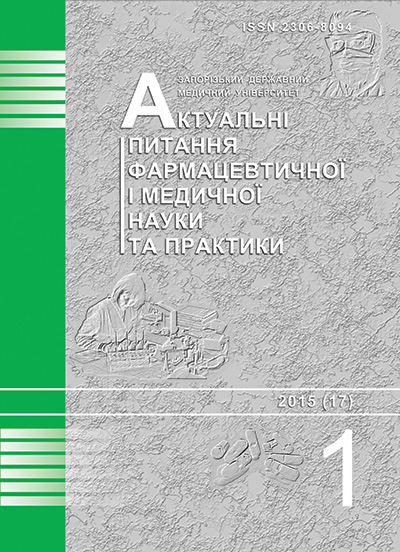SYNTHESIS AND ANTIMICROBIAL PROPERTIES OF 8-BENZYLIDENHYDRAZINO-1-n-PROPYLTHEOBROMINES
DOI:
https://doi.org/10.14739/2409-2932.2015.1.41393Keywords:
Xanthine, Organic Synthesis, NMR-spectroscopy, Antibacterial, Antifungal AgentsAbstract
Despite the wide application of brand-new instruments, continuous improvements in surgical treatment and application of up-to-date antiseptics and disinfectants within the last decade,a risk of infectious complications inhip and knee jointsendoprosthesis replacementstill remains.The most efficient results in post-surgery implant-related infection (IRI) treatment are attained when combining surgical interference with long-term etiotropic therapy, its efficiency being evaluated via balanced selection of antimicrobialagents.
“Perfect” antibacterial drug for surgical infection treatment must reveal bactericidal effect against specific infectious agents, form high concentrations in bones, joints and soft tissues and have high safety profile. The challenge is that currently for most part of antibiotics there is no convincing evidence in regards to their application for implant-related infection (IRI).
At present it is generally accepted that the leading role of S. Aureus and S. Epidermidis in IRI etiology is largely due to their ability to generate multi-level microbial biofilms quickly at the artificial implants surface. Pathogens’ presence in biofilms makes IRI diagnostics more complicated and significantly reduces the efficiency of antimicrobial therapy.
Earlier it has been determined that 1.8-disubstituted of theobromine show rather high diuretic, anti-inflammatory, analgesic, antioxidant, hypolipidemic and antimicrobial activity. Thus, the problem of discovering new highly efficient antimicrobial agents which might be applied in IRI treatment remains relevant and long-termissue.
Aim of the work is to develop simple laboratory methods to synthesize 8- benzylidenhydrazino-1-n-propyltheobromines and study biological activity of synthesized compounds.
Materials and Methods of Research
Themeltingpointhasbeendeterminedwiththehelpofanopencapillary methodwithTAPdevice(M).Elementalanalysishasbeenperformedwiththe help of the instrument ElementarVario L cube, NMR-spectra have been taken on a spectrometer Bruker SF-200 (operating frequency of 200 MHz, solvent DMSO, internal standard – TMS). These data correspond to thecalculated elemental analysis.For the initial screening study of the new synthesized substances there has been usedthebenchmarkscultureasgram-positiveandgram-negativebacteriawhich belongtodifferentmorphologicalpropertiesofclinicallyimportantgroupsof infectiousagents.AsasetofstandardteststrainswehavetakenEscherichiacoli ATSS 25922, Staphylococcus aureus ATSS 25923, Pseudomonas aeruginosa ATSS27853, Candida albicans ATSS 885-653. All test strains have been obtained from thelaboratorycalled"ZaporizhzhyaRegionalLaboratoryCenteroftheState epidemiological station of Ukraine." The sensitivity of microorganisms to promising antimicrobialnewsynthesizedsubstanceshasbeendeterminedaccordingtothe guidelines.Duringthestudiestherehavebeenpreparedtheserialtwo-fold dilutions of the drug in Mueller-Hinton broth in a volume of 1 ml, and then added to each tube 0.1 ml of microbial curtain (106 CFU / ml).
We havedeterminedtheminimuminhibitoryconcentration(MIC).Asthe solvent compounds we have used dimethylsulfoxidein the studies, the initial solution hasbeenadjustedtoaconcentrationof1mg/ml.Additionallywehaveheldthe control of culture media and solvent by the conventional methods.
Results
Heating of 8-bromo-1-n-propyltheobromine with an excess of hydrazine hydrate in aqueous dioxane leads to the formation of 8-hydrazino-1-n-propyltheobromine. Interaction of 8-hydrazinoptheobromine with aldehydes has lead to formation of a range of respective 8-benzylidenhydrazinoderivatives. Structure of synthesized compounds has been definitely proved by NMR-spectroscopy.It has beenfound, that synthesized 8-benzylidenhydrazino-1-n-propyltheobrominesexhibit mild effect.Index of antibacterial activity of some compoundsagainstStaphylococcus aureus and Candida albicans is approaching toAmpicillin andNystatin.
Conclusion
- Suggesting laboratory method to obtain 8-hydrazino-1-n-propyltheobromine, initial synthon for further xanthine molecule modification.
- Developing accessible laboratory methods to synthesize new 8-benzylidenhydrazino-1-n-propyltheobromines, which are potential bioactive compounds.
- Studying PMR-spectral characteristics of the obtained substances.
- Conducting primary screening research of antimicrobial activity of 8- benzylidenhydrazine derivatives, which revealed viability of further search for antistaphylococcal and antifungal drugs within this range.
References
Moriarty, T. F., Zaat, S. A. J., & Busscher, H. J. (2013). Biomaterials associated infection: immunological aspects and antimicrobial strategies. NY: Springer, London: Heidelberg Dordrecht.
Zimmerli, W., Trampuz, A., & Ochsner, P. E. (2004). Prosthetic-joint infections. N. Engl. J. Med., 351, 1645–1654. doi: 10.1056/NEJMra040181.
Geipel, U. (2009). Pathogenic organisms in hip joint infections. Int. J. Med. Sci., 6, 234–240.
Shirtliff, M. E., & Leid, J. G. (2009). The Role of Biofilms in Device-Related Infections. NY: Springer.
Stewart, P. S., & Costerton, J. W. (2001). Antibiotic resistance of bacteria in biofilms. The Lancet, 358(9276), 135–138. doi:http://dx.doi.org/10.1016/S0140-6736(01)05321-1.
Ivanchenko, D. H., Romanenko, М. І., Samura. B. A., Krisanova, N. V. (2009). Pat. № 38873 UA, С07D 473/00. 8-N-(Furyl-2)methylamino-1-p-chlorobenzyl theobromin, having diuretic, anti-inflammatory and antioxidant action. № u200809552; date of patent Jan. 26, 2009. Biul., 2. [in Ukrainian].
Ivanchenko, D. G., Romanenko, M. I., & Aleksandrova, K. V. (2012). Syntez, fizyko-khimichni ta biolohichni vlastyvosti pokhidnykh ksantynu. I. 1-benzyl-8-aminoteobrominy [Synthesis, physical-chemical and biological properties of 1,8-disubstituted compounds of theobromine. I. 1-Benzyl-8-aminotheobromines]. Aktualni pytannia farmatsevtychnoi i medychnoi nauky ta praktyky, 1(8), 36–39. [in Ukrainian].
Ivanchenko, D. G., Romanenko, M. I., Samura, B. A., Taran, A. V., & Kornienko, V. I. (2012). Syntez, fizyko-khimichni ta biolohichni vlastyvosti pokhidnykh ksantynu. II. 1-p-khlorobenzyl-8-aminoteobrominy [Synthesis, physical-chemical and biological properties of 1,8-disubstituted compounds of theobromine. II. 1-p-Chlorobenzyl-8-aminotheobromines]. Aktualni pytannia farmatsevtychnoi i medychnoi nauky ta praktyky, 2(9), 44–47. [in Ukrainian].
Ivanchenko, D. G., Romanenko, M. I., Kamyshny, A. M., & Polishchuk, N. M. (2014). Syntez, fizyko-khimichni ta biolohichni vlastyvosti 1,8-dyzamishchenykh teobrominu. III. 8-amino-1-p-khlorobenzylteobrominy [Synthesis, physical-chemical and biological properties of 1,8-disubstituted compounds of theobromine. III. 8-Amino-p-chlorobenzyltheobromines]. Aktualni pytannia farmatsevtychnoi i medychnoi nauky ta praktyky, 2(15), 45–49. [in Ukrainian].
Ivanchenko, D. H., Romanenko, М. І., Kornienko, V. I., & Samura, B. A. (2013). Pat. № 38873 UA, С07D 473/00. Piperazinium 1-n-butyltheobromine-8-ylthioacetate exhibiting diuretic action. №u201308690; date of patent Dec. 26, 2013. Biul, 23. [in Ukrainian].
Volianskyi, Yu. L., Hrytsenko, I. S., Shyrobokov V. P., Smirnov V. V., Biriukova S. V., Dykyi, I. L., et al. (2004). Vyvchennia spetsyfichnoi aktyvnosti protymikrobnykh likarskykh zasobiv [The study of the specific activity of antimicrobial medicines]. Kyiv. [in Ukrainian].
Downloads
How to Cite
Issue
Section
License
Authors who publish with this journal retain copyright and grant the journal right of first publication with the work simultaneously licensed under a Creative Commons Attribution License that allows others to share the work with an acknowledgement of the work's authorship and initial publication in this journal.


